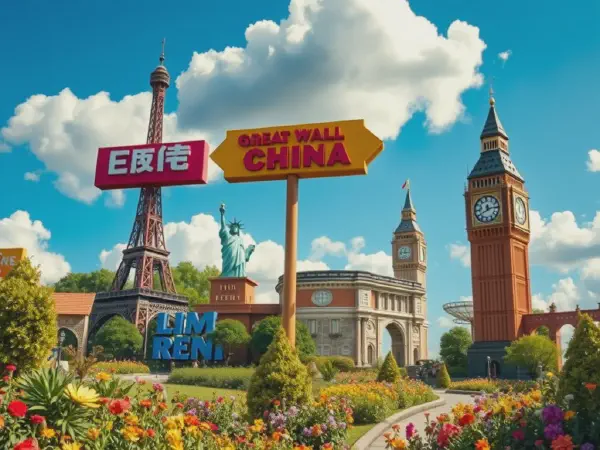Explore the World of Gigantic Signs: Your Ultimate Guide

Gigantic Signs: The Art and Impact of Oversized Advertising
Gigantic signs have long been a staple of the urban landscape, captivating the attention of passersby and creating memorable visual experiences. These monumental advertisements not only serve commercial purposes but also contribute to the cultural and aesthetic fabric of their surroundings. From towering billboards to colossal murals, gigantic signs have evolved to become iconic landmarks in cities around the world.
The significance of gigantic signs extends beyond mere advertising; they also represent a form of artistic expression that engages with both the environment and the viewer. In a world saturated with information and competing visual messages, the prominence of gigantic signs offers businesses a unique opportunity to stand out and communicate their brand messages effectively. As a result, understanding the role of gigantic signs in modern marketing strategies is essential for businesses looking to elevate their branding initiatives.
Furthermore, the construction and design elements of gigantic signs have transformed dramatically over the years. Advances in materials and technology have enabled the creation of more vibrant, durable, and eye-catching displays. Additionally, the psychological impact of colors and typography in sign design plays a crucial role in how audiences perceive and remember a brand. As we explore the world of gigantic signs, we delve into their history, design elements, branding significance, technological advancements, regulatory aspects, and cultural importance.
From the blazing neon lights of Times Square to the painted murals of community spaces, gigantic signs draw our gaze and provoke thought. These installations not only advertise products and services but also become part of the storytelling of a place. As urban centers continue to grow and evolve, the role of gigantic signs remains pivotal in shaping the visual identity of cities and influencing people's experiences within these spaces.
Ultimately, gigantic signs are more than just functional devices; they are landmarks that reflect societal values, trends, and local culture. By embracing the artistry and innovation involved in their creation, we can appreciate the impact that gigantic signs have on our environments and our lives.
History of Gigantic Signs
The origins of gigantic signs in advertising can be traced back to the late 19th and early 20th centuries, when businesses began to use larger-than-life displays to attract customers' attention. The rise of urbanization and industrialization led to more competition among businesses, prompting them to innovate in their advertising approaches. Billboards soon emerged as a popular medium, with their height and visibility allowing brands to make a significant impact on public consciousness.
Throughout the decades, sign design has evolved significantly, reflecting changes in art styles, technology, and consumer preferences. The mid-20th century saw the introduction of neon lighting, further revolutionizing how signs captured attention, especially at night. By the 1980s and '90s, digital screens began to dominate the landscape, enabling scrolling messages and dynamic graphics that changed the way businesses interacted with consumers.
Major milestones in the history of gigantic signs include the iconic Hollywood Sign, erected in 1923, which has become an emblem of the film industry. Similarly, Times Square in New York City emerged as a hotspot for gigantic advertising, with its buzzing neon lights and massive billboards, illustrating the dramatic shift in advertising strategies during the 20th century, ultimately paving the way for modern advertising practices.
Design Elements of Gigantic Signs
Creating a gigantic sign involves careful consideration of materials, with the choice often depending on factors such as location, durability, and visual impact. Common materials include metal, vinyl, acrylic, and LED technology. Each material brings unique attributes; for instance, metal can withstand the elements, while vinyl is cost-effective for large prints. The selection of materials ultimately affects not only the sign's longevity but also its aesthetic appeal.
Color psychology plays a critical role in sign design, as certain colors evoke specific emotions and associations. For instance, red can signify urgency or excitement, while blue often communicates trust and reliability. By strategically using color, businesses can influence how viewers perceive their brand, making it essential to choose colors that align with the brand's messaging and target audience's preferences.
Typography is another vital aspect of designing gigantic signs, with font choices impacting readability and brand recognition. Successful signage utilizes bold and easily readable typefaces to convey messages effectively. Furthermore, the choice of typography can reflect the brand's personality, whether edgy, traditional, or playful. Careful consideration of typography can greatly enhance the overall visual impact of a gigantic sign.
Gigantic Signs in Business Branding
Gigantic signs play a pivotal role in establishing brand identity, serving as a visual anchor that communicates a business's values and offerings to the public. A well-designed sign not only promotes a product or service but also creates an enduring impression that can lead to higher brand recall. This is especially vital for businesses in competitive environments, where differentiation is key.
Case studies of successful brand signage highlight the impact of gigantic signs on business growth. For instance, the iconic Coca-Cola sign in Times Square has become synonymous with the brand itself, contributing significantly to its worldwide recognition. Many businesses have reported increased foot traffic and improved sales after investing in prominent signage, demonstrating the tangible benefits of this marketing strategy.
To effectively incorporate gigantic signs into marketing strategy, businesses should consider factors such as location, design alignment with brand identity, and audience engagement. Collaborating with experienced designers and sign manufacturers can ensure that the final product aligns with the intended message and resonates with the target audience, maximizing the sign's impact.
Technology Behind Gigantic Signs
Innovative technologies have transformed the manufacturing of gigantic signs, enabling more intricate designs and enhanced visibility. Digital printing techniques allow for high-quality graphics and vibrant colors, while advanced materials have improved durability and resistance to fading. Furthermore, smart technology integration, such as interactive digital displays, provides opportunities for brands to create engaging, dynamic experiences for consumers.
When comparing LED to neon signage, each has its advantages and disadvantages. LED signs are energy-efficient, have longer lifespans, and can display dynamic content, making them suitable for modern marketing needs. Neon signs, on the other hand, offer a nostalgic aesthetic and warmth that appeals to certain target demographics. Understanding the strengths and limitations of these technologies is essential for making informed decisions in sign design.
Future trends in sign technology indicate a growing emphasis on sustainability and eco-friendly practices. As businesses become more conscious of their environmental footprint, the demand for energy-efficient lighting and recyclable materials is expected to rise. Additionally, innovations such as augmented reality (AR) signage may become more prevalent, allowing for interactive and immersive customer experiences.
Regulations and Safety for Gigantic Signs
Legal requirements for sign placement vary by location, with municipalities often implementing specific zoning laws that dictate sign size, height, and placement. Businesses must navigate these regulations to ensure compliance, protecting their investments and maintaining the integrity of their brand image. Understanding local laws is crucial, as violations can lead to fines or required removal of the sign.
Safety standards for construction and installation of gigantic signs are paramount, emphasizing the importance of well-engineered designs and quality materials. Signs must be structurally sound and securely anchored to prevent accidents. Professionals in sign manufacturing and installation are required to adhere to strict safety guidelines to mitigate risks and ensure public safety.
The impact of zoning laws on gigantic signs can significantly affect how businesses approach their signage strategies. In densely populated urban areas, zoning regulations may be stricter, resulting in limitations on the types of signs businesses can use. Understanding these regulations and engaging with local authorities can help businesses navigate potential challenges while maximizing their advertising potential.
Cultural Significance of Gigantic Signs
Gigantic signs often transcend their commercial purpose, becoming urban art installations that reflect the culture and identity of a community. Many cities have embraced this phenomenon, commissioning artists to create large-scale murals that beautify public spaces while also promoting local businesses. These artistic expressions often serve to energize neighborhoods, engage communities, and foster civic pride.
The influence of gigantic signs on local culture can be profound, shaping how residents perceive their environment and interact with it. They can become iconic symbols of a city, representing its history, values, and aspirations. For example, the famous "Hollywood" sign serves as a symbol of the entertainment industry and has fostered a unique cultural identity for Los Angeles.
Furthermore, gigantic signs can represent community identity through signage, showcasing local businesses, events, and initiatives that resonate with residents. By highlighting local heritage and storytelling, these signs contribute to fostering a sense of belonging and community cohesion among inhabitants. When designed thoughtfully and purposefully, gigantic signs can enrich public spaces and celebrate the identity of a community.
